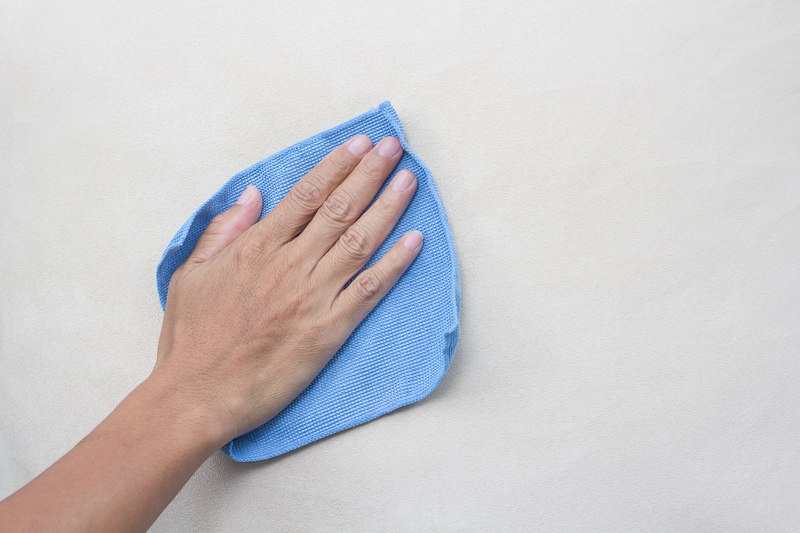Safeguarding Velvet Curtains: Cleaning Tips for Longevity
Posted on 02/06/2025
Safeguarding Velvet Curtains: Cleaning Tips for Longevity
Velvet curtains transform ordinary rooms into spaces of luxurious comfort and elegance. With their rich textures and bold presence, they are a coveted addition to both modern and classic interiors. However, maintaining the beauty of velvet can be challenging because it easily attracts dust, absorbs odors, and is sensitive to moisture and abrasion. This comprehensive guide will provide expert velvet curtain cleaning tips and practical advice to ensure your drapes remain beautiful for years to come.
Understanding Velvet Curtains: Why Special Care is Essential
Velvet is a distinctive fabric with a dense pile, unique sheen, and plush feel. Unlike other materials, the pile can crush or become dull with improper handling or aggressive cleaning. Knowing the composition and characteristics of your velvet curtains is the first step to safeguarding their longevity.
- Natural Velvet: Made from silk or cotton, this type is more delicate and requires ultra-gentle cleaning techniques.
- Synthetic Velvet: Polyester or nylon velvets are more durable but still benefit from specialized care.
- Blended Velvets: A mix of fibers, these can sometimes withstand more moisture, but always check labels or consult the manufacturer.

Common Velvet Curtain Cleaning Mistakes to Avoid
Before diving into effective cleaning methods, it's crucial to avoid some common pitfalls that can shorten the life of your velvet curtains:
- Machine Washing: Most velvet fabrics cannot withstand the agitation of washing machines; fibers can mat and lose their luster.
- Scrubbing Stains: Aggressive rubbing can crush the pile, causing permanent marks.
- Excess Moisture: Soaking or over-wetting velvet can shrink, stretch, or distort the fabric.
- Harsh Chemicals: Bleach, strong detergents, or unsuitable stain removers can discolor or damage velvet fibers.
Key Takeaway
The best way to clean velvet curtains is gentle, regular maintenance and targeted treatments for specific issues.
Weekly Maintenance: Keeping Velvet Curtains Dust-Free
Routine care is the cornerstone of velvet curtain maintenance. Dust and airborne particles settle quickly on velvet, making regular attention essential for longevity. Here's how to do it safely:
Vacuuming Velvet Curtains
- Use a vacuum cleaner with a soft brush or upholstery attachment.
- Work in the direction of the pile (usually downward) to avoid crushing fibers.
- Adjust the suction setting to the lowest level, especially for delicate or natural velvet.
- Vacuum gently at least once a week or more often in dusty environments.
Tip: Place a stocking or mesh over the vacuum nozzle for added protection.
Shake and Refresh
- Once or twice a month, carefully untie and shake the curtains outdoors to loosen deep-seated dust.
- Let the fabric air out to disperse any absorbed odors.
Spot Cleaning Velvet Curtains: Gentle Approaches
Spills and stains happen. Immediate attention is vital to avoid them setting and causing permanent damage. Use these steps to address stains on your velvet curtains:
- Blot, Don't Rub: As soon as the spill occurs, blot gently with a soft white cloth to absorb as much liquid as possible. Never rub!
- Test an Inconspicuous Area: Before treating the visible area, apply your cleaning solution to a small, hidden part of the fabric to check for colorfastness.
- Mild Detergent Solution: Mix a few drops of gentle dish soap with lukewarm water. Dampen a clean sponge or cloth, then dab the stain softly.
- After cleaning, blot with a dry towel to remove excess moisture.
- Allow to air dry naturally. Avoid heat (hair dryers, sunlight, or radiators).
- Once dry, gently brush the area in the direction of the pile to restore its texture.
Products to Use or Avoid
- Use: Mild detergent, distilled water, white vinegar for light odors (sparingly).
- Avoid: Bleach, strong stain removers, solvents like acetone or alcohol, or any colored cloth that might bleed.
Deep Cleaning Velvet Curtains: When and How
Beyond regular dust removal and spot cleaning, your curtains will require periodic deep cleaning to maintain their brilliance. Depending on exposure to dirt and direct sunlight, aim for a deep clean every 6-12 months.
Professional Dry Cleaning
- Check the care label: Most designers and manufacturers recommend professional dry cleaning for fine velvet curtains, especially those made from silk or natural fibers.
- Choose a cleaner with experience in handling velvet to avoid shrinkage, color bleed, or pile damage.
At-Home Deep Cleaning
For durable synthetic velvets, you may occasionally wash them at home with caution:
- Handwashing: Fill a tub with lukewarm or cold water and a dash of gentle detergent.
- Fully submerge one panel at a time. Swirl gently. Do NOT wring, twist, or scrub.
- Rinse thoroughly with cool water.
- Support the entire panel's weight when lifting out of water to prevent stretching.
- Lay flat on a towel to dry or hang while supporting the base to avoid pulling and distortion.
- Once dry, use a soft-bristled brush to lift the nap (pile) gently.
Steam Cleaning Velvet Curtains
Steaming is a safe and effective way to refresh and sanitize velvet, restore crushed pile, and remove wrinkles:
- Use a quality handheld or upright garment steamer.
- Steam gently from top to bottom, keeping the nozzle 1-2 inches away from the fabric.
- Do not leave the steamer in one spot for too long; this could cause water stains.
- For deep creases, hold the steamer slightly closer and brush the pile with a soft cloth while steaming.
Steaming is highly recommended for ongoing care, especially between deep cleans.
How to Handle Odors and Allergens
Velvet curtains can absorb odors from cooking, smoke, or pets. For lingering smells or allergies caused by dust mites or pollen:
- Air Out Regularly: Open windows or hang the curtains outside on a breezy day (keep them out of direct sunlight).
- Lightly mist with a 1:3 solution of distilled white vinegar and water to neutralize odors, then allow to air dry completely.
- Baking Soda Sprinkle: For persistent smells, sprinkle baking soda, leave for 15-30 minutes, and vacuum gently.
Protecting Velvet Curtains from Damage
Cleanliness alone won't ensure the longevity of your velvet drapes. Preventative care will preserve both their texture and color.
- Avoid Direct Sunlight: Continuous exposure will cause fading and weaken fibers. Use sheer undercurtains or blinds for protection.
- Minimize Handling: The oils and dirt from hands can stain and flatten velvet. Use curtain rods or wands when opening and closing.
- Reduce Humidity: In damp climates, run a dehumidifier to prevent mold or mildew on your curtains.
- Rotate curtain positions or panels occasionally to ensure even wear and sun exposure.
The Importance of Proper Storage
If you need to store your velvet curtains, proper storage is crucial:
- Clean and dry thoroughly before storing.
- Fold loosely (do not compress), interleaving layers with acid-free tissue paper.
- Store in a cool, dry, dark environment in a breathable cotton bag--not plastic, which can trap moisture.
- Do not hang curtains in a cramped closet where they could be crushed.
Restoring Crushed Velvet and Luster
Even with careful maintenance, velvet pile can flatten over time. Restore its signature plushness with these steps:
- Hang curtains in a steamy bathroom or use a garment steamer, gently brushing the pile with a velvet brush or a soft, lint-free cloth.
- Avoid over-steaming; a few gentle passes are enough.
- For stubborn spots, place a clean piece of white fabric over the area and lightly press with a warm (not hot) iron. Never touch the iron directly to velvet!

Frequently Asked Questions About Velvet Curtain Care
Can all velvet curtains be dry cleaned?
Natural fiber velvets always require professional dry cleaning. Some synthetic varieties can be hand-washed, but always check the manufacturer's care instructions first.
What is the best way to remove pet hair from velvet curtains?
Use a soft lint roller, a gentle fabric brush, or vacuum with an upholstery tool. For persistent hair, slightly dampen a rubber glove and run it over the fabric.
Is ironing velvet curtains safe?
Direct ironing can flatten the pile. If needed, use a steam iron with a pressing cloth between the iron and the velvet, keeping heat and pressure light. Always test on an inconspicuous area.
How can I prevent wrinkles in velvet curtains?
Hang curtains promptly after cleaning or storage. Regular gentle steaming will remove small creases and freshen up the pile.
Conclusion: Velvet Curtain Cleaning for Lasting Beauty
Safeguarding velvet curtains doesn't require complicated routines, but it does demand consistent, gentle care and thoughtful handling. By adopting the tips above--regular vacuuming, prompt spot cleaning, periodic steam or dry cleaning, and mindful storage--your velvet drapes will retain their luxurious look and feel for many years. Remember, using proper techniques is not just about cleaning, but preserving the elegance, value, and beauty of your velvet curtains for the long run.
With careful attention and these expert tips, your favorite velvet window treatments will continue to make a statement in your home while standing the test of time.
```
